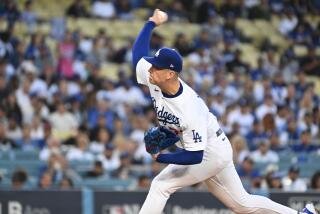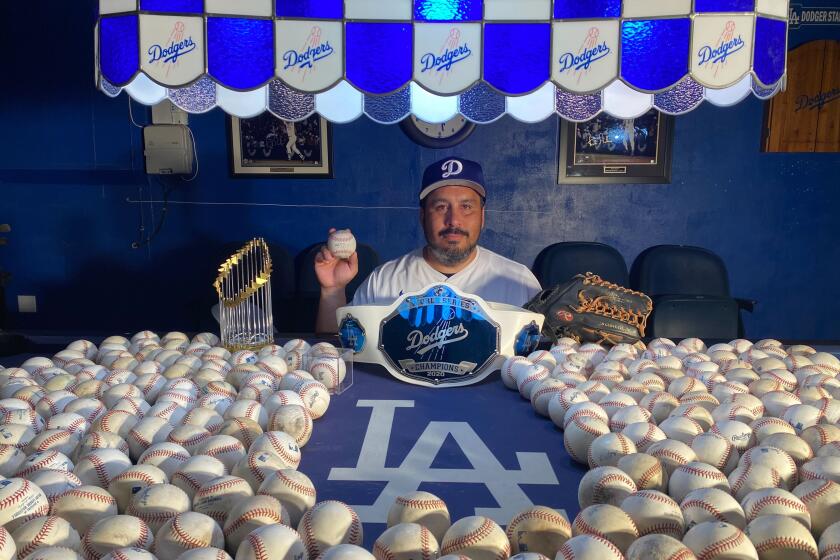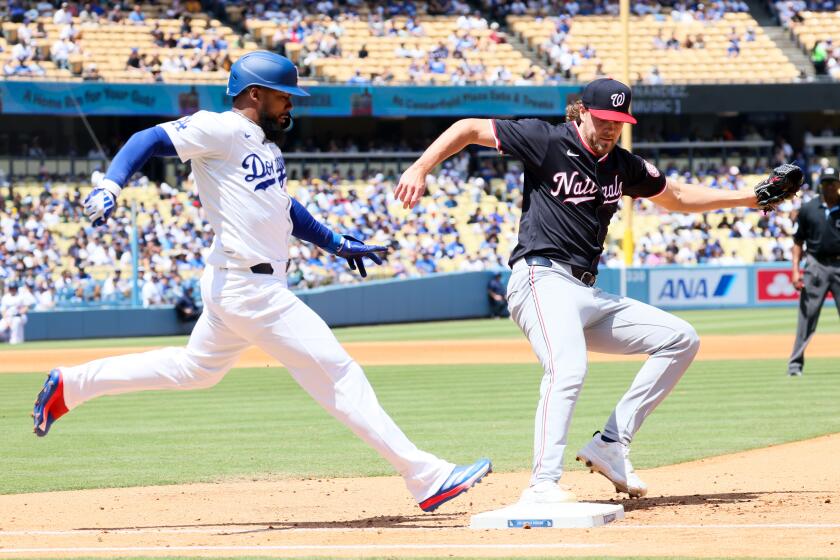Dodgers Dugout: Who are the three best right fielders in team history?
Hi, and welcome to another edition of Dodgers Dugout. My name is Houston Mitchell and it’s time to continue selecting the all-time 40-man roster for the Dodgers.
The all-time team, right field
Before we get to center field, let’s again lay down the ground rules on who is eligible for the polls.
First, we are counting only what they did as a Dodger. Frank Robinson is one of the greatest players of all time, but he played only one season with the Dodgers, so he won’t be appearing here.
Second, position players had to play at least 500 games with the Dodgers, or have had such an iconic moment or season with the team that it wouldn’t make sense to leave them off. (It’s the Kirk Gibson rule.)
Third, only games played since 1901 count. My apologies to those who played before then.
Fourth, players who competed at multiple positions will be listed at the position where they played the most games for the Dodgers. For example, Jim Gilliam played multiple positions for the Dodgers, but he played the most games at second base, so he was listed there.
Finally, you can vote for three players at each position. There will be a link to a site where you can make your selections at the end of each player list. With that, let’s get to it. There are 15 right fielders who meet the criteria for the Dodgers.
Let’s look at them using three stats: OPS+ (on-base percentage plus slugging percentage, which compares them to the league-average hitter each season, making it easier for us to do cross-era comparisons; a league-average hitter will have an OPS+ of 100), WAR (wins above placement, which shows career value) and defensive WAR (which gives a general idea of how well they fielded). Those three stats don’t give a complete picture, but it should give you an overall sense of the value of each player. I encourage you to do further research on each player if you are unsure about them.
OPS+
Reggie Smith, 152
Babe Herman, 144
Harry Lumley, 134
Shawn Green, 130
Dixie Walker, 129
Yasiel Puig, 127
Frank Howard, 125
Raul Mondesi, 122
Andre Ethier, 122
Casey Stengel, 119
Willie Crawford, 118
Mike Marshall, 117
Carl Furillo 112
Ron Fairly, 110
Tommy Griffith, 97
WAR
Carl Furillo, 35.1
Dixie Walker, 33.5
Babe Herman, 23.1
Raul Mondesi, 21.6
Andre Ethier, 21.2
Shawn Green, 21.0
Willie Crawford, 19.8
Reggie Smtih, 19.4
Yasiel Puig, 18.6
Harry Lumley, 14.7
Ron Fairly, 12.9
Frank Howard, 10.9
Casey Stengel, 10.8
Mike Marshall, 10.2
Tommy Griffith, 3.6
Defensive WAR
Yasiel Puig, 1.5
Reggie Smith, 0.4
Willie Crawford, -0.1
Raul Mondesi, -1.2
Carl Furillo, -2.1
Shawn Green, -3.2
Dixie Walker, -3.3
Casey Stengel, -3.4
Frank Howard, -4.4
Tommy Griffith, -5.2
Harry Lumley, -5.7
Babe Herman, -7.1
Mike Marshall, -8.2
Andre Ethier, -8.4
Ron Fairly, -9.9
A closer look at the players (statistics are with Dodgers only):
Willie Crawford (1964-75, .268/.351/.413): Crawford first played for L.A. as a 17-year-old in 1964 and had his best season in 1973, when he hit .295/.396/.453 with 14 homers and 66 RBIs. He was solid defensively, playing shallower than most right fielders to cut down on bloop singles and relying on his speed to catch any balls hit over him. “He was big and powerful, and he could hit a ball as far as anybody. Boy, was he something,” Tommy Lasorda once said of Crawford, who the Dodgers signed out of Fremont High. He never developed into the great player many thought he would, but he was a productive player for many years and retired after the 1977 season. Crawford died of kidney disease at age 57 in 2004. You can read more about him here.
Andre Ethier (2006-17, .285/.359/.436): On Dec. 13, 2005, the Dodgers made one of their best trades ever when they sent Milton Bradley and Antonio Perez to Oakland for Andre Ethier, who became their starting right fielder for the next 10 seasons and put himself on many all-time top 10 lists in L.A. Dodgers history. You knew what you were going to get from Ethier every season: A .280-.290 average with about 20 homers and 80 RBIs. He was the first Dodger to have at least 30 doubles in seven consecutive seasons, made the All-Star team twice and won a Gold Glove. It was 2009 though when Ethier became a fan favorite. He had six walk-off hits that season, four of them home runs. He played in a franchise record 51 postseason games and retired in 2018 after two injury-marred seasons.
Ron Fairly (1958-69, .260/.347/.385): Fairly joined the Dodgers as a 19-year-old rookie and quickly became a quiet mainstay with the team, playing first base until Wes Parker came along in 1965 and chased him to right field. His best year was 1966 when he hit .288/.380/.464 with 14 homers and 61 RBIs and he played on three Dodger World Series title teams. His numbers fell off in 1967 and early in the 1969 season he was traded to Montreal along with Paul Popovich for Manny Mota and Maury Wills. Fairly was only 30 and played nine more seasons in the majors, retiring after playing a season with the Angels in 1978. He is one of the few players who appeared in 1,000 games at first base and 1,000 games in the outfield. He was an Angels broadcaster for several years before calling games for the Giants and the Seattle Mariners. Now retired, Fairly lives in Palm Desert and released a first-person memoir last year titled “Fairly at Bat: My 50 years in baseball.”
Carl Furillo (1946-60, .299/.355/.458): “The Reading Rifle” led the NL in batting average at .344 in 1953, the second of his two All-Star seasons with the Dodgers. He finished sixth in MVP voting in 1949 when he hit .322 with 27 doubles, 10 triples, 18 homers and 106 RBIs. He was a good fielder with a great arm, racking up 24 assists in 1951, more than earning his nickname. He was a steady player for the Dodgers for years and played in seven World Series with the team, including the 1955 and 1959 title teams. Years later, in the book Bums by Peter Golenbock, Furillo talked about what it meant to win that 1955 World Series: “Oh God, that was the thrill of all thrills. I never in my life seen a town go so wild. You did it for yourself, too, but you did it for the people.” The Dodgers released Furillo during the 1960 season and he moved back east. He helped install the elevators in the World Trade Center buildings. On Jan. 21, 1989, he died of heart failure at the age of 75.
Shawn Green (2000-04, .280/.366/.510): Green played in only five seasons with the team, but one of those years included the greatest offensive game by a Dodger in their history. On May 23, 2002 in Milwaukee, Green hit four home runs, a double and a single, drove in seven runs and scored six runs. Green became a hero to many in the Jewish community the season before, when he ended his consecutive games played streak at 415 games in order to observe Yom Kippur. “I felt like it was the right thing to do. ... I didn’t do this to gain approval. I thought it was the right example to set for Jewish kids, a lot of whom don’t like to go to synagogue,” Green said. Green was also known for giving away his batting gloves to a kid in the stands after every home run. The Dodgers traded Green to Arizona before the 2005 season for Dioner Navarro and three minor leaguers. He played three more seasons in the majors and retired at age 34.
Tommy Griffith (1919-25, .285/.333/.394): Griffith was a speedy outfielder who was an average hitter, though he did bat .312 in 1921 and .316 in 1922. He also wasn’t a great baserunner despite his speed. One of my favorite stats: In 1915 with Cincinnati, Griffith stole six bases and was caught 24 times. When Griffith lost a step of his speed, he lost his usefulness and was traded to the Chicago Cubs for Bob Barrett near the start of the 1925 season. He was out of the majors after that season and lived in Cincinnati for the rest of his life, working a series of jobs until dying of pneumonia at 77 in 1967.
Babe Herman (1926-31, 1945, .339/.396/.557): Babe Herman was a great hitter and a lousy fielder who will always be remembered for one thing: doubling into a double play. On Aug. 15, 1926, the Dodgers were playing the Boston Braves. With one out and the bases loaded, Herman launched a fly ball to right that looked like it would be caught, but it hit the wall. The runner on third scored, but the runner on second, Dazzy Vance, rounded third and stopped, unsure if the ball had been caught. The runner on first, Chick Fewster, saw Vance round third and assumed he was going to score, so Fewster rounded second and continued to third, where he met the confused Vance. Meanwhile Herman, head down all the way, came sliding into third with what he thought was a triple. The base belonged to Vance, so Fewster and Herman were tagged out, inning over. What often gets overlooked, the run Herman did knock in turned out to be the winning run in the game. Also, Herman played so well that season that the Dodgers released aging future Hall of Famer Zack Wheat, convinced Herman could replace him. Herman’s best season came in 1930, when he hit .393 with 48 doubles, 11 triples, 35 homers and 130 RBIs. Tempering those numbers a bit is the fact the entire league hit .303 in 1930 and despite those lofty numbers, Herman amazingly didn’t lead the league in anything. Herman led the team in homers in RBIs in 1931 and hit for the cycle twice. He got into a salary dispute with the team after the season and the Dodgers traded him to Cincinnati. He left the majors after the 1937 season but in 1945, with the Dodgers in a pennant race and players scarce because of the war, GM Branch Rickey asked Herman, who had been playing in the Pacific Coast League, if he would like to return to the Dodgers. Herman, 42, said sure and hit .265 with a double, homer and nine RBIs in 34 at-bats. He retired for good and became a long-time scout for various teams. Babe Herman died in Glendale on Nov. 27, 1987 at age 84.
Frank Howard (1958-64, .269/.326/.495): At 6-7 and 255 pounds, Frank Howard was an imposing player who could hit the ball a country mile. This was back in the day when the average major league player was about 5-10, 180 pounds. After brief appearances with L.A. in 1958 and 1959, he broke through in 1960, hitting .268 with 23 homers and 77 RBIs, good enough to earn him NL Rookie of the Year honors. He hit only 15 homers in 1961, after which doctors made a discovery: Howard needed glasses. Now able to see, he hit 31 homers and had 119 RBIs in 1962 and hit 28 homers for the 1963 World Series champions, going three for 10 with a double and a homer in the sweep of the Yankees. But Howard slumped badly in 1964, hitting only .226 and the Dodgers started to believe they needed more speed and pitching on the team, so they traded Howard to Washington, along with third baseman Ken McMullen and pitchers Phil Ortega and Pete Richert for pitcher Claude Osteen and infielder John Kennedy. He had greater success after leaving the Dodgers, hitting 246 homers in eight seasons with Washington/Texas. He finished his career with 382 home runs and there is a statue of Frank Howard outside of the Washington Nationals’ stadium in D.C. Howard is currently enjoying retirement at age 82.
Harry Lumley (1904-10, .274/.328/.408): Lumley led the NL as a rookie with 18 triples and nine homers in 1904 and had his best season in 1906, when he hit .324 with 23 doubles, 12 triples and nine homers, leading the league with a .477 slugging percentage. Unfortunately, injuries, including a broken ankle, derailed his career. The Dodgers named him player-manager in 1909 and the team finished 55-98. It was his only year as manager. He played in only eight games in 1910 before he was released, never playing in the majors again. He died in Binghamton, N.Y. in 1938 at age 57.
Mike Marshall (1981-89, .271/.325/.446): Marshall had a lot of gifts, including tremendous power, but he also seemed to miss every other game with a variety of ailments, including missing one game, I kid you not, for “general soreness.” As Lasorda once put it, “It was frustrating because this guy had all the ability in the world and didn’t utilize it to the extent he should have.” Marshall was a key member of the 1988 World Series title team, putting together one of his best seasons and hitting a key three-run homer in Game 2 against the A’s. Still, most fans remember him as the guy who didn’t play because he had a headache, or a toothache, or a hangnail, or seasonal allergies. Today, Marshall looks back and has some regrets, telling Bill Plaschke, “I know I was not very well liked. … I wish I had been tougher. I wish I had played. “Some of my injuries, did I handle them perfectly? No, that was something I always regretted. I always wanted to be 100%. I always thought the team was better with someone else if I wasn’t 100%. But, in hindsight, there are times I should have just rolled myself out there. You’re in your 20s, you’re stupid, you make a lot of silly mistakes, a lot of silly decisions. You hate to have regrets, but, well, I have regrets.” You can read more about Mike Marshall here.
Raul Mondesi (1993-99, .288/.334/.504): Mondesi is sort of the original Yasiel Puig. He was an exciting player to watch who played Gold Glove-level defense in right, but also made a lot of baserunning mistakes and wasn’t always popular with his teammates. He was named NL Rookie of the Year in 1994 after hitting .306 with 16 home runs and 56 RBIs and in 1997 became the first Dodger to join the 30-30 club when he hit 30 homers and stole 32 bases. He was traded to Toronto after the 1999 season along with Pedro Borbon for Shawn Green and bounced around the majors after that, with his career ending in 2005. He was elected mayor of his hometown, San Cristobal, Dominican Republic in 2010 and in 2017 was sentenced to eight years in prison for corruption and mishandling of public funds while mayor. His son plays for the Kansas City Royals.
Yasiel Puig (2013-18, .279/.353/.478): I don’t believe there’s much more I can write about Puig that I haven’t written in the last four years. You know his strengths and weaknesses, all you have to decide now is he one of the three best right fielders in team history.
Reggie Smith (1976-81, .297/.387/.528): Reggie Jackson got the headlines, but the best Reggie in right field from 1977-78 was Reggie Smith. Which seems appropriate, because Steve Garvey got the headlines on the Dodgers even though Smith was a better player those two years, finishing fourth in MVP voting both seasons and leading the league in OB% in 1977 with an amazing .427 mark. That season, he hit .307 with 32 homers and 87 RBIs and scored 104 runs. And you didn’t mess with Smith or one of his teammates while he was with the Dodgers. In 1981, the Dodgers were playing the Pittsburgh Pirates when their pitcher, Pascaul Perez, hit Bill Russell by a pitch. The Dodgers demanded that Perez, who had a reputation of throwing at batters, be warned. The umpires refused. A couple of batters later, Perez hit Dusty Baker. Smith leveled a series of threats and profanities at Perez. After the inning, Perez motioned to Smith that he would meet him under the stands. The two players raced up their respective dugout tunnels and met behind home plate, under the stands. On TV, all we saw was both dugouts emptied as players from both teams also raced up the tunnels. It looked as if everyone had vanished. Amazingly, no one was ejected, and Perez even pitched the next inning. The Dodgers won the game. Smith left the majors after the 1982 season and played two years in Japan. He worked for the Dodgers as a coach, was the hitting coach for the 2000 gold-medal winning U.S. baseball team and is probably best known for his youth baseball camp and the Reggie Smith Baseball Center in Encino.
Casey Stengel (1912-17, .272/.346/.393): Yes, this is the same Casey Stengel who went on the become one of the most legendary managers in history. He played 14 seasons in the majors, the first six with the Dodgers, where he quickly gained a reputation for having a keen batting eye, leading the league with a .404 OB% in 1914. He was a great defensive player, but the Dodgers got tired of him holding out for more money before every season and traded him to Pittsburgh for pitchers Burleigh Grimes and Al Marmaux and infielder Chuck Ward.
Dixie Walker (1939-47, .311/.386/.441): Walker played for 18 seasons in the majors but had his greatest success with Brooklyn, making the All-Star team four times in eight seasons, leading the league in hitting in 1944 (.357) and in RBIs in 1945 (124). Nicknamed “The People’s Choice,” he was extremely popular among Brooklyn fans, but now is mostly remembered for trying to keep Jackie Robinson from joining the team. He was among a group of Dodgers in spring training of 1947 who petitioned the team not to put Robinson on the team and, when they did, Walker asked GM Rickey to trade him. Walker and Robinson did their best to avoid each other during the season, and after the season, Walker credited Robinson for much of the team’s success. Robinson also credited Walker for giving him a batting tip early in the season. Years later, in an interview with Roger Kahn, Walker said “I organized that petition in 1947, not because I had anything against Robinson personally. … I had a wholesale business in Birmingham and people told me I’d lose my business if I played ball with a black man.” Walker apologized and added “A person learns, and you begin to change with the times.” After the 1947 season, the Dodgers traded Walker to Pittsburgh for Billy Cox, Gene Mauch and Preacher Roe. Walker was a batting coach for the Dodgers from 1968-74 and died of colon cancer at age 71.
Now it’s time for you to vote. Remember to vote for three. You can click here to vote, or you can email me your three choices. Ties are not allowed, and you have to vote for three. Vote for more or fewer and your vote won’t count.
Next week: The wild-card round. We bring back some of the losers and you get to pick the best two to add to the team.
Who were the three best center fielders?
Here are the results, after receiving 14,295 ballots:
1. Duke Snider (named on 99.42% of ballots)
2. Willie Davis (86.8%)
3. Matt Kemp (38.9%)
4. Pete Reiser (38.3%)
5. Brett Butler (19%)
6. Rick Monday (13.3%)
7. Joc Pederson (1.7%)
8. Johnny Frederick (1.3%)
9. Derrel Thomas (0.8%)
10. Ken Landreaux (0.7%)
11. Hi Myers (0.3%)
The 40-man roster so far:
Catchers
Roy Campanella
Mike Piazza
Mike Scioscia
Infielders
Adrian Beltre
Ron Cey
Steve Garvey
Jim Gilliam
Gil Hodges
Davey Lopes
Wes Parker
Pee Wee Reese
Jackie Robinson
Bill Russell
Justin Turner
Maury Wills
Outfielders
Dusty Baker
Tommy Davis
Willie Davis
Matt Kemp
Duke Snider
Zack Wheat
Coming up
Jan. 15: Wild-card
Jan. 22: Starting pitchers
Jan. 29: Relief pitchers
Feb. 5: Managers
And finally
Last week, I wrote that Duke Snider hit 40 or more homers in four consecutive seasons. It was actually five. Dopey me. Also, watch Shawn Green hit four home runs in one game. Watch it here.
Have a comment or something you’d like to see in a future Dodgers newsletter? Email me and follow me on Twitter: @latimeshouston.
Twitter: @latimeshouston
More to Read
Are you a true-blue fan?
Get our Dodgers Dugout newsletter for insights, news and much more.
You may occasionally receive promotional content from the Los Angeles Times.







